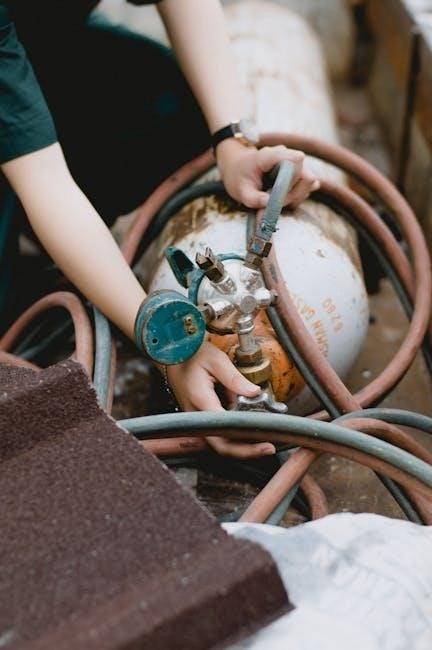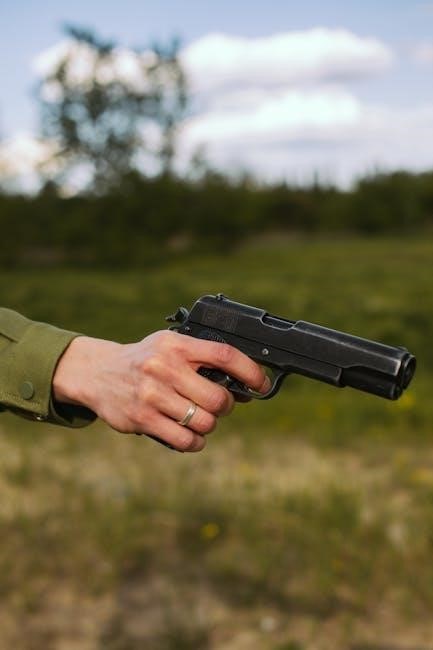Manual Safety vs. Trigger Safety: A Comprehensive Comparison
The debate between manual and trigger safeties in handguns centers on user preference and operational philosophy. Manual safeties offer an extra layer of security, requiring deliberate action. Trigger safeties, conversely, integrate directly into the trigger, preventing movement unless engaged correctly. This comparison explores each type’s nuances.
Handgun safeties are critical mechanisms designed to prevent unintentional or accidental discharges. These safeties come in various forms, each with its own set of advantages and disadvantages. The primary goal of any handgun safety is to ensure the firearm only fires when the user intends it to, reducing the risk of negligent incidents. This is achieved through mechanical designs that block the trigger, firing pin, or both, from engaging unless a specific action is taken by the user.
Among the most common types of handgun safeties are manual safeties and trigger safeties. Manual safeties typically involve an external lever or switch that the user must physically manipulate to enable or disable the firearm’s firing mechanism. Trigger safeties, on the other hand, are integrated directly into the trigger itself and require a specific action, such as pressing a lever within the trigger, to allow the gun to fire.
The choice between manual and trigger safeties often comes down to personal preference, training, and intended use. Some shooters prefer the positive confirmation of a manual safety, while others prioritize the speed and simplicity of a trigger safety. Understanding the nuances of each type of safety is essential for responsible gun ownership and safe handling practices.
Defining Manual Safeties
Manual safeties are external mechanisms on firearms that require the user to physically engage or disengage them. These safeties are typically levers, switches, or buttons located on the frame or slide of the handgun. Their primary function is to prevent the firearm from firing unless the safety is deliberately deactivated by the user. This adds an extra layer of protection against accidental discharges, particularly in situations where the firearm is dropped or mishandled.
The design of manual safeties can vary significantly across different handgun models. Some common configurations include thumb safeties, which are operated by the thumb of the shooting hand, and cross-bolt safeties, which are pushed from one side to the other. Regardless of the specific design, the underlying principle remains the same: to provide a tangible and deliberate step that must be taken before the firearm can be fired.
Many gun owners appreciate manual safeties for the added peace of mind they provide. They offer a clear indication of whether the firearm is ready to fire, reducing the risk of unintentional discharges. However, it’s crucial to remember that manual safeties are not a substitute for safe gun handling practices and proper training. Responsible gun ownership always involves prioritizing safety and following established protocols.
Defining Trigger Safeties
Trigger safeties represent a distinct approach to firearm safety, integrating the safety mechanism directly into the trigger itself. These safeties typically consist of a small lever or blade positioned within the trigger face. The firearm can only be fired when the user intentionally depresses this lever in conjunction with pulling the trigger. This design aims to prevent accidental discharges by requiring a deliberate and precise action.
Unlike manual safeties, which are external and require a separate step to engage or disengage, trigger safeties are automatically activated when the finger is removed from the trigger. This integrated design eliminates the need for a distinct action, streamlining the firing process while maintaining a degree of safety. Trigger safeties are commonly found in striker-fired pistols and are a key component of systems like the Glock “Safe Action” system.
Proponents of trigger safeties emphasize their simplicity and speed of deployment. They argue that the absence of an external safety allows for a faster draw and firing sequence, which can be crucial in self-defense situations. However, critics express concerns about the potential for accidental discharges if the trigger is inadvertently manipulated or if the safety mechanism fails. As with any safety feature, proper training and adherence to safe gun handling practices are essential for minimizing risks.


The Glock Safe Action System
The Glock Safe Action System is a prime example of a firearm design that prioritizes integrated safety mechanisms over traditional manual safeties. It’s a system comprised of three independent, automatic safeties: a trigger safety, a firing pin safety, and a drop safety. These safeties work in conjunction to prevent unintentional firing without requiring the user to manipulate an external switch or lever.
The trigger safety, perhaps the most visible component, is a lever within the trigger face that must be fully depressed along with the trigger for the gun to fire. The firing pin safety is a spring-loaded block that prevents the firing pin from moving forward unless the trigger is pulled completely. Lastly, the drop safety prevents the firing pin from moving if the pistol is dropped.
The absence of a manual safety in Glock pistols has been a topic of debate among gun owners. Proponents of the Safe Action System argue that it simplifies operation, reduces the risk of forgetting to disengage a safety in a critical situation, and provides a consistent trigger pull. Critics, however, express concern that the lack of an external safety increases the risk of accidental discharge, particularly in stressful situations or when handling the firearm under duress. Despite the ongoing debate, the Glock Safe Action System has proven to be a reliable and widely adopted design.

Advantages of Manual Safeties

Manual safeties offer a distinct advantage in providing an additional layer of security against accidental discharge. This external control, typically a lever or switch, allows the user to physically prevent the firearm from firing, offering a tangible sense of security. This is especially beneficial in situations where the firearm might be handled by someone unfamiliar with its operation, such as during cleaning or storage.
For individuals who prioritize redundancy in safety mechanisms, manual safeties provide peace of mind. They serve as a backup in case other safety features, like trigger safeties, fail. Moreover, some users feel more comfortable carrying a handgun with a manual safety engaged, particularly in certain carry positions or when the gun is holstered in a less secure manner. This can be crucial for maintaining confidence and reducing anxiety associated with carrying a loaded firearm.
In high-stress scenarios, the presence of a manual safety can provide a moment of conscious thought before firing, potentially preventing negligent discharges. While training is essential to ensure quick and efficient disengagement, the added step can act as a mental checkpoint. For those accustomed to firearms with manual safeties, transitioning to a system without one can feel unsettling, highlighting the psychological comfort these devices offer.
Disadvantages of Manual Safeties
Despite their perceived safety benefits, manual safeties present potential drawbacks, particularly in high-pressure self-defense situations. The necessity to disengage the safety adds a step to the firing process, potentially costing valuable time when immediate action is required. This extra step can be especially problematic for individuals who lack consistent training or those who may fumble under stress.
Furthermore, the reliance on a manual safety can lead to a false sense of security, causing users to become complacent with other essential safety practices like trigger discipline and proper handling. If the user forgets to disengage the safety in a critical moment, the firearm will fail to fire, rendering it useless. This can be a devastating consequence in a life-threatening encounter.
Manual safeties can also be prone to mechanical failure. They are small parts that can break or become obstructed, preventing them from being disengaged properly. This risk is amplified if the firearm is not regularly maintained. Some argue that manual safeties can snag on clothing or holsters, leading to unintended disengagement or, conversely, preventing the firearm from being drawn smoothly. Ultimately, the disadvantage lies in the potential for human error and mechanical failure to compromise the firearm’s immediate usability.
Advantages of Trigger Safeties
Trigger safeties offer a streamlined approach to firearm safety, primarily by integrating the safety mechanism directly into the trigger itself. This design eliminates the need for a separate, external switch or lever, simplifying the firing process and potentially reducing response time in critical situations. Because the safety is disengaged as a natural part of pulling the trigger, it minimizes the risk of forgetting to deactivate the safety under stress, a significant advantage in self-defense scenarios.
The simplicity of trigger safeties also contributes to enhanced user-friendliness, especially for those new to firearms. The intuitive design reduces the learning curve and promotes consistent operation. This can lead to greater confidence and proficiency in handling the firearm safely. Moreover, trigger safeties are less prone to accidental engagement or disengagement compared to external manual safeties, as they require a deliberate and direct action on the trigger itself.
Another advantage lies in their unobtrusive nature. Since they are integrated into the trigger, they do not add bulk or complexity to the firearm’s design. This can be particularly beneficial for concealed carry, where a streamlined profile is essential for comfort and ease of access; The consistent engagement of the safety with proper trigger pull promotes good trigger discipline, a fundamental aspect of responsible firearm handling.
Disadvantages of Trigger Safeties
While trigger safeties offer simplicity, they also present certain drawbacks. One primary concern is the potential for accidental discharge if the trigger is not handled with utmost care. Because the safety mechanism is directly linked to the trigger, any unintended pressure or object interfering with the trigger can inadvertently deactivate the safety and cause the firearm to fire. This is especially concerning in situations where the firearm is dropped or comes into contact with other objects.
Another disadvantage is the reliance on the user’s consistent and proper trigger finger placement. If the finger is not positioned correctly on the trigger, the safety may not fully disengage, leading to a failure to fire when needed. This can be a critical issue in high-stress situations where fine motor skills may be compromised. Furthermore, trigger safeties may not provide the same level of perceived security as manual safeties, as they do not offer a visible or tactile indication of whether the firearm is safe or ready to fire.
The lack of an external safety mechanism can also be a concern for those who prefer a more tangible barrier against accidental discharge. Manual safeties provide a clear visual and physical confirmation that the firearm is in a safe state. This can be particularly reassuring for users who are new to firearms or who handle them infrequently. Additionally, trigger safeties may not be suitable for all users, especially those with limited hand strength or dexterity, as they require a certain amount of force to disengage the safety while simultaneously pulling the trigger.
Training and Proficiency Considerations
Regardless of the type of safety mechanism a handgun employs, comprehensive training and maintaining proficiency are paramount for safe and effective firearm handling. For handguns equipped with manual safeties, training should emphasize the consistent and reflexive engagement and disengagement of the safety during the draw stroke and firing sequence. Users must develop the muscle memory to manipulate the safety without conscious thought, ensuring that it becomes an ingrained part of their shooting process. Regular practice drills, incorporating both dry-fire and live-fire exercises, are essential to reinforce these skills.
For handguns with trigger safeties, training should focus on proper trigger finger placement and control. Users must learn to consistently position their finger correctly on the trigger to ensure the safety disengages smoothly and reliably. Emphasis should also be placed on avoiding unintended pressure on the trigger, especially during holstering and re-holstering. Drills that simulate various shooting scenarios, including those involving movement and unconventional positions, can help users develop the necessary skills to handle their firearm safely and effectively under stress.
Moreover, regardless of the safety mechanism, it is crucial for users to understand the limitations of their firearm and to adhere to all applicable safety rules and regulations. Regular refresher courses and advanced training opportunities can help users stay up-to-date on best practices and improve their overall firearm handling skills. Ultimately, the responsibility for safe firearm handling rests with the individual user, and consistent training and proficiency are the cornerstones of responsible gun ownership.
The decision between a manual safety and a trigger safety ultimately boils down to individual preferences, training, and intended use. There’s no universally “right” choice, as both systems offer distinct advantages and disadvantages. Consider your comfort level and willingness to train diligently. If you prefer the added layer of security and are committed to consistently engaging and disengaging the safety, a manual safety might be ideal. However, recognize the potential for added complexity in high-stress situations.
Alternatively, if you prioritize simplicity and a streamlined draw, a trigger safety could be more suitable. With trigger safeties, ensure you maintain impeccable trigger discipline and utilize a quality holster that fully covers the trigger guard. Reflect on your shooting experience and how you plan to carry the firearm. Are you accustomed to a particular type of safety? Will the gun be primarily for self-defense, competition, or recreational shooting?
Finally, research different firearms and their safety mechanisms. Handle them if possible, and seek advice from experienced shooters and instructors. Remember, the most important safety feature is the person holding the gun. Proficiency in safe gun handling, regular training, and adherence to all firearm safety rules are paramount, regardless of the type of safety your chosen handgun employs. Make an informed decision based on your needs and commit to mastering your firearm.
